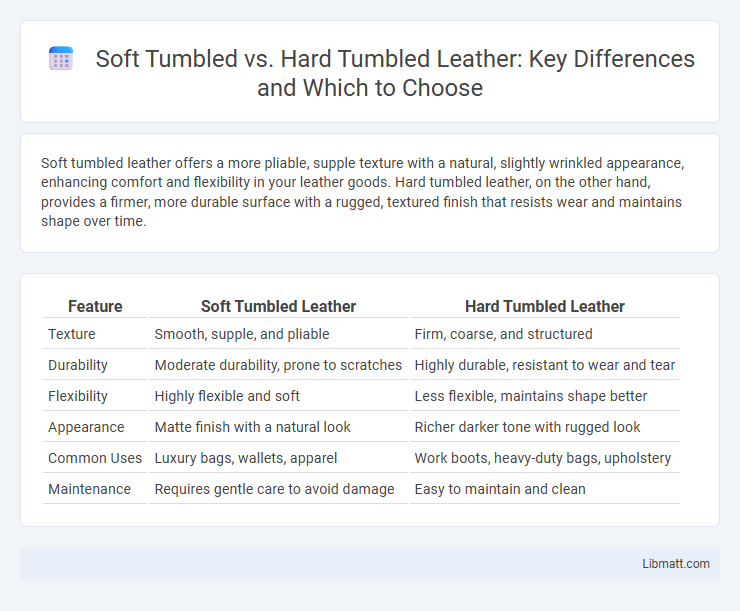Soft tumbled leather offers a more pliable, supple texture with a natural, slightly wrinkled appearance, enhancing comfort and flexibility in your leather goods. Hard tumbled leather, on the other hand, provides a firmer, more durable surface with a rugged, textured finish that resists wear and maintains shape over time.
Table of Comparison
| Feature | Soft Tumbled Leather | Hard Tumbled Leather |
|---|---|---|
| Texture | Smooth, supple, and pliable | Firm, coarse, and structured |
| Durability | Moderate durability, prone to scratches | Highly durable, resistant to wear and tear |
| Flexibility | Highly flexible and soft | Less flexible, maintains shape better |
| Appearance | Matte finish with a natural look | Richer darker tone with rugged look |
| Common Uses | Luxury bags, wallets, apparel | Work boots, heavy-duty bags, upholstery |
| Maintenance | Requires gentle care to avoid damage | Easy to maintain and clean |
Understanding Tumbled Leather: An Overview
Tumbled leather undergoes a specialized tumbling process to enhance softness and flexibility by repeatedly agitating the leather in a drum, which breaks down stiffness and yields a natural, grainy texture. Soft tumbled leather is characterized by a more supple feel and visible creases, making it ideal for products requiring comfort and flexibility, while hard tumbled leather retains more firmness and durability for structured items. Understanding the distinction between these two types helps you choose the appropriate leather quality based on the desired balance between softness and strength.
What is Soft Tumbled Leather?
Soft tumbled leather is a type of leather treated to create a supple, pliable texture by tumbling the hides in a drum with natural oils and waxes. This process enhances the leather's softness while preserving its durability, making it ideal for products requiring flexibility and comfort. Your choice of soft tumbled leather ensures a luxurious feel combined with long-lasting performance.
What is Hard Tumbled Leather?
Hard tumbled leather is a type of leather treated through a rigorous tumbling process that enhances its durability and creates a rugged, textured surface. This method uses heavy mechanical action to break down the leather fibers, resulting in a stiffer material with a distinct, pebbled grain that resists scratches and wear. Ideal for products requiring long-lasting strength, hard tumbled leather maintains its shape and develops a rich patina over time.
Key Differences Between Soft and Hard Tumbled Leather
Soft tumbled leather features a supple texture with a gentle, broken-in feel created by a longer tumbling process, enhancing pliability and comfort. Hard tumbled leather undergoes a shorter, more intense tumbling, resulting in a firmer, more durable surface with increased resistance to wear and scratches. The key differences lie in the leather's flexibility, texture softness, and suitable applications, with soft tumbled ideal for garments and accessories requiring comfort, while hard tumbled suits heavy-use items like boots and work gear.
Texture and Feel: Soft vs. Hard Tumbled Leather
Soft tumbled leather features a plush, supple texture with a smooth, flexible feel that conforms comfortably to your touch, making it ideal for items requiring a gentle, luxurious finish. Hard tumbled leather offers a firmer, more structured texture with pronounced grain patterns, providing durability and a rugged, tactile experience suited for heavy-use accessories. Your choice between soft and hard tumbled leather impacts both the aesthetic and functional quality of leather goods, balancing comfort against resilience.
Durability and Longevity Comparison
Soft tumbled leather offers a supple texture with moderate durability, making it ideal for products requiring flexibility and comfort. Hard tumbled leather undergoes rigorous tumbling, resulting in a denser, thicker material that provides enhanced resistance to wear and tear, significantly extending the lifespan of goods. The dense fibers and tightly packed grain in hard tumbled leather ensure superior longevity compared to the slightly more delicate soft tumbled variant.
Visual Aesthetics: Which Finish Stands Out?
Soft tumbled leather features a smooth, supple surface with subtle creases that enhance its natural grain, creating a refined and luxurious visual appeal perfect for high-end fashion and accessories. Hard tumbled leather presents a more rugged, textured finish with pronounced wrinkles and a matte look, offering a durable and vintage-inspired aesthetic often favored in casual or workwear styles. The choice between soft and hard tumbled leather depends on the desired visual effect--sleek elegance versus bold character--impacting the overall perception of any leather product.
Common Uses and Applications
Soft tumbled leather, prized for its pliability and smooth texture, is commonly used in fashion accessories such as gloves, handbags, and jackets where comfort and flexibility are essential. Hard tumbled leather, characterized by its robust durability and coarse finish, is often applied in rugged goods like work boots, belts, and motorcycle gear that demand long-lasting wear resistance. Both types leverage their unique tactile properties to meet specific functional and aesthetic requirements in leather craftsmanship.
Care and Maintenance Tips
Soft tumbled leather requires gentle cleaning with a damp cloth and conditioning every 3-6 months using leather-specific products to maintain its supple texture and prevent drying. Hard tumbled leather benefits from less frequent conditioning but needs regular dusting and protection from excessive moisture to retain its durability and rugged appearance. Both types should be stored in breathable conditions away from direct sunlight to avoid cracking and discoloration.
Choosing the Right Tumbled Leather for You
Soft tumbled leather offers a supple texture and enhanced flexibility, ideal for products requiring a gentle, pliable feel, such as handbags and gloves. Hard tumbled leather provides increased durability and structural integrity, making it suitable for items subjected to heavy wear like boots and belts. Selecting the right tumbled leather depends on balancing the need for softness against the demand for toughness, ensuring the material aligns with the intended use and longevity requirements.
Soft tumbled vs hard tumbled leather Infographic

 libmatt.com
libmatt.com